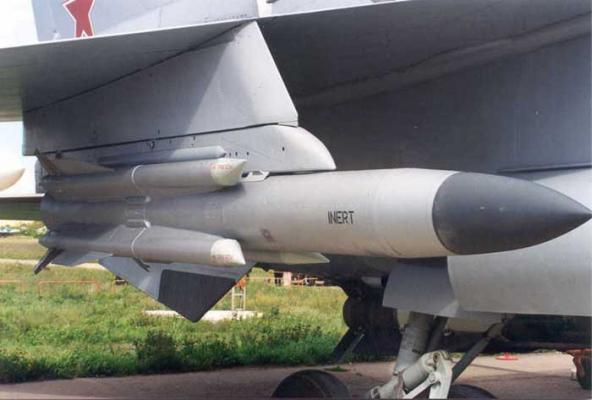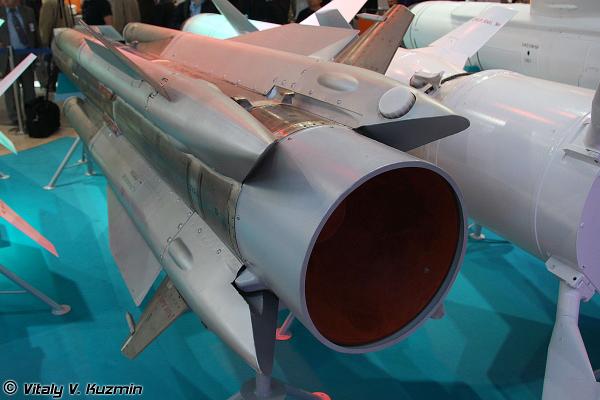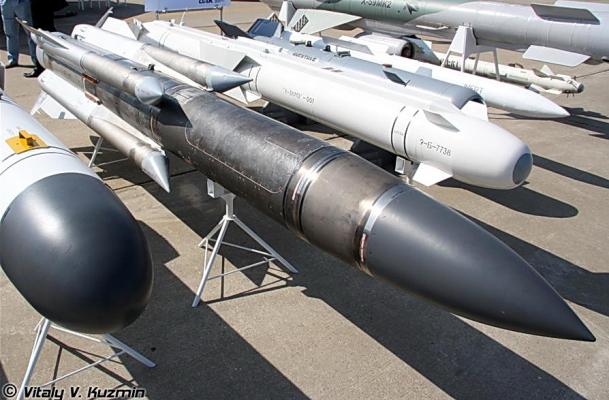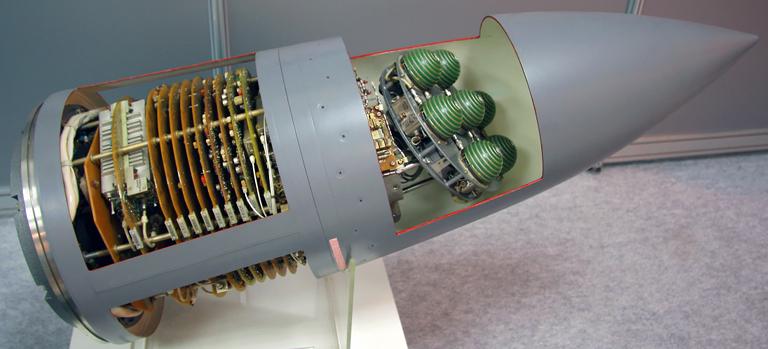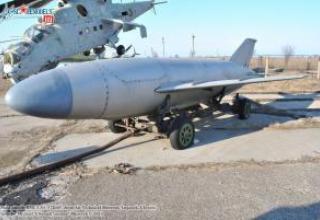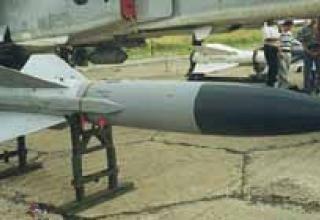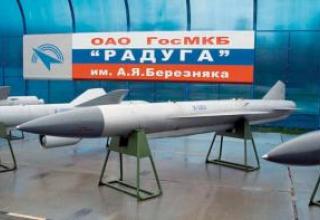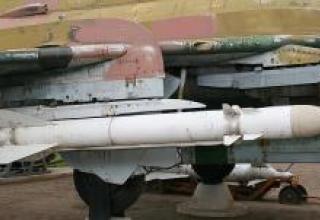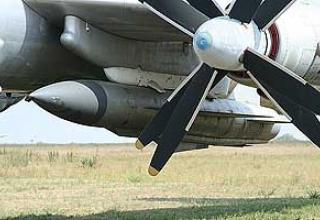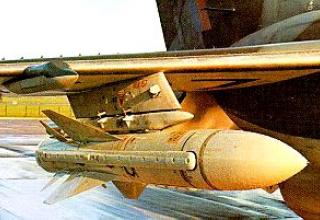X-31P supersonic aircraft missile with passive homing head is intended for destruction of enemy air defense systems radar controls, including medium- and long-range air defense radars "Patriot", "Improved Hawk", "Nike Hercules" and others. It differs from the anti-radar missiles of the previous generation in that it has a longer range, high marching speed, stable targeting under conditions of intensive interferences and temporary shutdown of the radio-radiation targets.
The development of the X-31P antiradar missile (APR) began in 1975 at the Design Bureau "Zvezda" under the leadership of Chief Designer G.I.Khokhlov. The necessity of its creation was caused by the fact that its predecessor, the Kh-27PS PRR, did not satisfy the customer in terms of its launch range and speed, forcing the carrier to launch the missile in the range of the "Hawk" and "Nike Hercules" SAMs with the maneuver to move away from the target, which, in turn, allowed the calculation of the SAMs to turn off the radar, thus disrupting the guidance of the PRR. It was assumed that the new missile would have a launch range of about 60 km and a mass of less than 400 kg, and its high speed (about 750 m/sec at launch range of 25 km from a low altitude) would allow it to ensure the hitting of the "Advanced Hawk" SAM system's high-explosive warhead before the launch of the SAM reaches the carrier. It was planned to hit Nike Hercules SAM system radars outside the range of the SAM system. The plan was to arm the SLBMs with third-generation attack aircraft of the MiG-27, Su-17M and Su-24 types, each of which would house at least two missiles. To ensure the required average speed at a given mass, it was decided to use SARD. To accelerate the missile to the launch speed of the SARP, a solid propellant launch accelerator was used, which could be placed in the SARP combustion chamber.
During the design process, it became clear that it would not be possible to build a missile weighing less than 400 kg, primarily because of the difficulty of creating a small-size RVD. Thus, instead of a lightweight RVD, a medium-range RVD was obtained to suppress air defense with a launch range, The list of radar targets for the X-31 missile was also expanded to include SAM-D (future Patriot) and surveillance radars operating in the B and C frequency bands, for which the Omsk-based NGO "Automatics" was given the task of designing three SLNs (PRGS-4PV, PRGS-5PV and PRGS-6PV) operating in these bands.
In the process of creation of X-31 missile in 1978 the government decree on creation on its basis of anti-ship version, which received designation X-31A, intended for destruction of surface ships with displacement up to 4500 tons was issued. For this purpose, the X-31 missile was equipped with an active radar SLN and a penetrating combat unit instead of a shrapnel-array one.
Factory flight tests of the X-31P began in May 1982 on the MiG-27M aircraft. On them, the missile was presented in versions Pr1 and Pr2, as well as its dimensional and mass models to check the emergency drop. Equipped with a launch engine and a mock-up of the cruise engine X-31Pr1 was designed to test the separation of the rocket, its launch and stabilization at the launch site. X-31Pr2 with the launch and marching engines of the power plant was designed to test the launch of the marching engine, determine its characteristics, assess the performance of the stabilization system, check aerodynamic and ballistic characteristics.
November 22, 1983 began Phase "A" of the state joint testing of the rocket X-31 with GSN PRGS-4VPV as part of the weapons system of the MiG-27M aircraft. By this time, the X-31 has undergone structural changes, externally expressed primarily in changing the shape of the wing and its place of installation to increase the stability of the missile. In parallel with the beginning of 28 August 1984, stage "B" of state joint flight tests of the X-31 missile in the weapons system of MiG-27M was developed a list of measures to modify the X-31 missile to improve its performance. Improvement of ballistic characteristics was planned to achieve a reduction in aerodynamic resistance by performing the nose in a single caliber (360 mm) with a combustion chamber of the marching stage, which would also lead to an increase in the reserve of marching fuel, reducing the size of the rods, elimination of gaps and gaps between the mating elements of the frame, installation of steering wheels in the plane of the wings, and so on. The technological process was planned to be improved by providing a better approach to the plug-in connectors to be connected, laying the harnesses inside the compartments to ensure their reliable thermal insulation, more rational layout and simplification of unit installation. Operational reliability was increased by providing the plane assembly and equipment of the rocket without unblocking it by installing the ignition unit, laying a part of the elctronic harnesses and checking them during the engine assembly, installation of pyropatrons at the plant without removing the fairings during operation, installation of the combat unit through the hatch, rather than from the end causing the need to disconnect the compartment with the guidance and control equipment. A detailed analysis of each structural element was performed to reduce the launch weight of the missile.
In February 1986 the flight and design tests of the modernized X-31P rocket were successfully conducted. In late spring, continued the "B" stage of the state joint flight tests of the weapons system of the MiG-27M aircraft with a prototype rocket Kh-31P and prototype equipment "Progress-N". In early June 1987, stage "B" flight tests were completed and the missile was recommended for mass production and adoption for service.
Factory flight tests of the rocket X-31P with GSN PRGS-5VP began in January 1986 and conducted on the MiG-27M aircraft with the equipment "Progress-H". Then, in February 1987, the Su-24M (T6M-37) was hooked up and the flight development tests of the Kh-31A rocket were continued on two aircraft. In the third quarter of 1987, practical launches of the Kh-31P rocket with PRGS-5VP were performed from the Su-24M, allowing the factory flight tests to be successfully completed on 8th September 1987.
At the end of September 1987, state joint flight tests of this missile started, conducted on MiG-27M and Su-24M aircraft and successfully completed at the end of March 1988, after which X-31P with PRGS-5VP was recommended for service. At the same time, control equipment that provided target designation for the CNS missiles - "Phantasmagoria" and "Ethnography" containers for the Su-24M and "Progress" for the MiG-27 and Su-17 - was also tested.
In early spring 1988, the factory flight tests of the X-31P missile with the PRGS-6VP began. They were completed at the end of April 1988, followed by state joint testing of this version of the MiG-27M missile in the second half of 1988, with a positive result. As the reconnaissance sighting station operating in B + C and B' and intended for installation on the Su-24M had not been developed by that time, it was not possible to launch X-31 P rockets with the GSN PRGS-6VP from it. Therefore, the Su-24M prototype (T6M-37), which had been further developed for the use of Kh-31P rockets, was used in May 1988 to perform test series tests of Kh-31P rockets manufactured in 1987, during which the possibilities of using Kh-31P rockets with SNS PRGS-4PVP from the aircraft were also tested.
Serial production of missiles X-31P at the Kaliningrad Production Association "Arrow" (now SNRC "Zvezda-Strola") began in 1987.
The development of the upgraded version of X-31PK missile was carried out by equipping the missile with a non-contact blast sensor and a warhead of increased efficiency. The X-31PK tactical missile with passive homing heads is designed to effectively engage the radar, including those with upward facing antenna devices (up to 15 m), operating in continuous and pulsed modes of radiation.
The extended range of the missile up to 110 km ensures its effective use, mainly from abroad, the reach of the enemy's air defense missile carrier. Due to the high speed combined with the autonomy of guidance, provides an advantage in dual situations where the launch is carried out from ranges to the target within the reach of the missile launchers of air defense missiles.
At present, an advanced X-31PD missile with an extended range is offered. In addition, a version of the missile class "air-to-air" to combat aircraft DRLO.
In the west, the missile was designated AS-17 "Kripton".
Composition:
The X-31P rocket (see projections) is made according to the normal aerodynamic scheme with the X-shaped arrangement of the wing and rudders. The missile consists of three compartments. Each compartment is a structurally and functionally complete unit. On the hull in the plane of the bearing surfaces are four side round supersonic air intakes, closed by conical shaped plugs ejected in flight. The X-31P rocket is equipped with a shrapnel-phase warhead, upgraded with the X-31PD - a cassette universal one, weighing 110 kg, of increased power.
The 31DPK engine is a direct-flow air jet designed by Soyuz ICB (Turaevo, Moscow Oblast). It consists of: air intakes, fuel tanks with displacement system and fuel dosing equipment, front-end device, combustion chamber with unregulated supersonic nozzle, electrohydraulic system of combustion control.
The combustion chamber of the marching engine accommodates a solid fuel launch accelerator, which after separation of the rocket from the launch vehicle reliably ensures its acceleration to the launch speed of the marching SARD. After operation is complete, the booster is pushed out by a racing air stream. The use of such an integrated propulsion system provides an increase in the average speed and range of firing while reducing the size of the missile. The combustion chamber of the direct-flow air jet engine has an air curtain cooling system, which significantly increases the allowable operating time and opens up almost unlimited opportunities for modification of the missile. The specific fuel consumption during operation of the RVD 31DPK is approximately 6 times lower than that of the RDTT, and low smoke increases flight stealth. The original solution ensured a self-launch of the missile with the SARP (which usually requires upper stages) and stable operation at the maximum specific impulse. The design of the 31DPC is simple, compact and inexpensive to produce, but highly reliable. And the use of solid propellant in the SARP has simplified the storage and operation of the missile. At high speed, the missile was able to perform maneuvers with high overloads, which reached 10g in tests.
The guidance system of the upgraded X-31PD missile includes an inertial system and a wide-band passive homing radar head (WBH) L-112E, manufactured by NPO "Automatics".
The X-31P rocket provided application after target capture on a suspension under the carrier. The X-31P rocket can be used in two modes: in conjunction with the capture of the target on the auto-support CPSN under the suspension of the aircraft carrier and in an autonomous mode with the capture of the target on the auto-support CPSN on the trajectory of the missile after launch. The choice of mode is made by the launch vehicle crew, depending on the altitude and range of target detection. PRGS provides search and seizure of the target on the suspension under the aircraft carrier data carrier equipment or autonomously, as well as target tracking and the formation of signals to guide the missile. After its detection, the pilot sends the aircraft to the target and enters the target designation data in the missile. After launch, the rocket goes into altitude dialing mode according to the program. Then, when you reach a certain angle of target sighting, CNS turns to it and dive, while pointing at the target is carried out on the signals of CNS.
Ground operation of the missiles is provided by the complex of preparation of aircraft destruction means "Oka-E-1".
A sealed container is used to transport and store the missile.
Characteristics:
| X-31P | Х-31PD | |
| Range, km: - maximum - minimum |
110 15 |
180-250 15 |
| Flight Speed, m/s: - maximum - middle |
1000 600-700 |
|
| Flying speed of the carrier, km/h | 600-1250 (0.65<М<1.5) | |
| Launch height, km | 0.1-15 | |
| Dimensions, mm: - length - maximum housing diameter - wingspan - steering wheel range |
4700 360 778 914 |
5340 360 - 954 |
| Start weight , kg | 600 | 715 |
| Weight of combat unit, kg | 87-90 | 110 |
| The angle of bearing of the target at launch: - target acquisition under the carrier - trajectory capture |
±15° ±30° |
|
| Aviation launcher AKU-58 | ||
| Developer | Vimpel ICB | |
| Weight of empty PU, kg | 185 | |
| Dimensions, mm: - length - width - altitude |
3810 130 220 |
|
Testing:
On the basis of the X-31P rocket was created target missile MA-31 (removed the homing head, combat equipment and partly modified the aerodynamic scheme of the nose fairing). Target MA-31 in 1994 won the world competition announced by the U.S. Navy and successfully passed the flight tests. Four launches of the MA-31 target missile were conducted at the U.S. Navy test site in Point Mugu, California. The contract for the sale of target missiles MA-31 of the U.S. Navy, involves the supply of 20 to 40 X-31 missiles per year.
One version of why the Americans paid attention to the X-31 is the desire of the U.S. Navy Command to develop a missile defense system capable of protecting ships from another supersonic Russian cruise missile 3M-80E "Mosquito" - in the NATO classification SS-N-22 "Sunburn" ("Solar Burn"). This anti-ship weapon system of the state company Rosvooruzhenie sold as part of the arms of the destroyer 956 project type "Modern" to the Chinese. The presence of weapons in the Chinese, against which no effective defense systems exist in any fleet of the world, poses a serious threat to the impunity of the U.S. Pacific Fleet operations in Southeast Asia, and it cannot but bother the American admirals.
Sources:
- А.В.Карпенко, С.М. Ганин "Отечественные авиационные тактические ракеты", "Бастион" N1, 2000г.
- Ракета Х-31ПД
- Ракета Х-31ПК
- В. Марковский, К. Перов , "Советские авиационные ракеты "воздух-земля". — М.: ООО «Издательский центр «Экспринт» 2005.
- «Авиация ВВС России и научно-технический прогресс», под ред. Е.А.Федосова. — М.: Дрофа, серия «Авиация и комонавтика» 2005.
